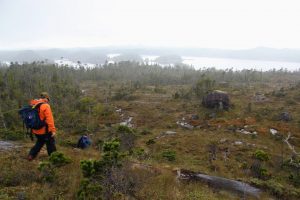28 September 2018
Ice age discovery may reveal early migration route of first Americans
Posted by kcawdrey
By Joe Paxton
Researchers discovered the retreat of an ancient ice sheet from the western coast of Canada occurred earlier than previously thought.
Christopher Darvill from The University of Manchester’s Department of Geography is the lead author on a new paper published in Geophysical Research Letters, a journal of the American Geophysical Union.
Darvill and his co-authors studied the Cordilleran Ice Sheet in North America – which once covered an area the size of the Greenland Ice Sheet – to improve our understanding of past climate and ancient human migration.
The retreat of the ice sheet controlled when routes were opened that allowed ancient people to migrate south into the Americas. Which route was used – and when – remains a highly contentious topic among archaeologists and geologists.
Darvill and colleagues from universities in Canada and the U.S. used a helicopter to reach remote island locations along the Canadian coast. The team chipped rock samples from the tops of boulders and bedrock, before taking them back to a lab to investigate further.
The findings should help archaeologists target investigations tracing the migration pathways of early people into the Americas.
“Our work changes the model of when this ice sheet retreated in the past, improving our understanding of past climate change over western North America,” said Darvill. “The new findings add an exciting piece to the puzzle surrounding the colonization of the continent.”
–Joe Paxton is a news and media relations officer in the University of Manchester’s Division of Communications and Marketing. This post originally appeared as a news article on the University of Manchester’s website.











 GeoSpace is a blog on Earth and space science, managed by AGU’s Public Information staff. The blog features posts by AGU writers and guest contributors on all sorts of relevant science topics, but with a focus on new research and geo and space sciences-related stories that are currently in the news.
GeoSpace is a blog on Earth and space science, managed by AGU’s Public Information staff. The blog features posts by AGU writers and guest contributors on all sorts of relevant science topics, but with a focus on new research and geo and space sciences-related stories that are currently in the news.
The development of human intelligence and abilities was stimulated by “seafood” gathering as evidenced by shell middens. The unpleasant and life-threatening storms and catastrophic glacial flooding obliterated much evidence for villages by the sea. Consider the changes in sea level affecting living conditions. During times of catastrophic flooding, the people up high enough survived and may have been those seeking migration to safer areas.
Isotope chemistry scores yet another scientific triumph…
During Ice Age people of the North Pole region migrated to southern about 30 to 40 thousand years ago, facing catastrophic atmospheric oppressions. This hardship made them intelligent and efficient to discover the laws of existence. Gradually they cross the Ural mountains and settled down near green plane grassland of Russia. These were Aryans, the common forefathers of British, Germans, Greek, Scandinavian, Iranians, Central Asians and Indias as well.